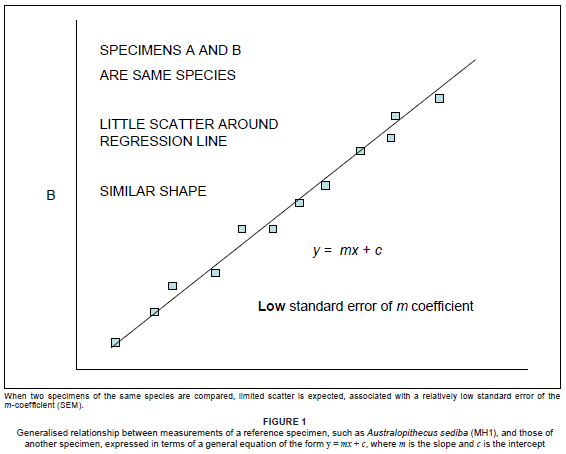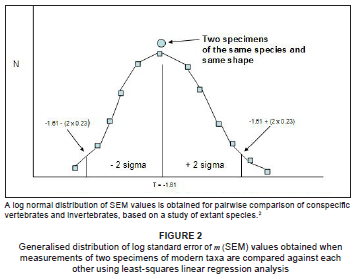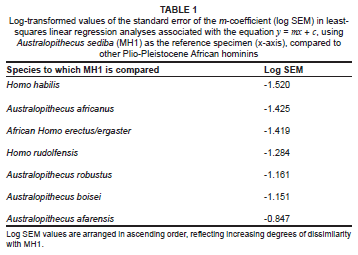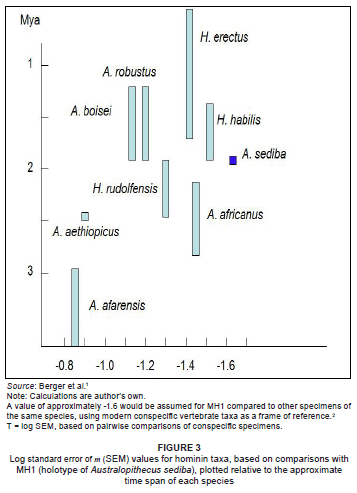Services on Demand
Article
Indicators
Related links
-
 Cited by Google
Cited by Google -
 Similars in Google
Similars in Google
Share
South African Journal of Science
On-line version ISSN 1996-7489
Print version ISSN 0038-2353
S. Afr. j. sci. vol.106 n.7-8 Pretoria Jul./Aug. 2010
SCIENTIFIC CORRESPONDENCE
Comparisons between Australopithecus sediba (MH1) and other hominin taxa, in the context of probabilities of conspecificity
J. Francis Thackeray
Institute for Human Evolution, University of the Witwatersrand, South Africa
Berger et al.1 report the remarkable discovery of two hominin specimens (MH1 and MH2) attributed to a new species, Australopithecus sediba, dated to almost 2 million years ago, from the Malapa site in South Africa. They present cranial data for MH1 that can be compared with corresponding measurements for other Plio-Pleistocene hominin taxa using least-squares regression analysis, as illustrated in Figure 1. In the study discussed here, results are presented to show degrees of similarity between MH1 and other hominin species.

In pairwise comparisons of linear dimensions, using MH1 as the reference specimen, the slope m in the least-squares linear regression equation y = mx + c is associated with variability in size (measurements for MH1 being associated with the x-axis). However, the log-transformed value of the standard error of the m co-efficient (log SEM) is a measure of the degree of scatter around the regression line and relates to variability in shape, as compared to a reference specimen. Limited scatter around the regression line occurs when two specimens belong to the same species. Under such circumstances, the log SEM values are relatively low. By contrast, a higher degree of scatter around the regression line (and relatively high log SEM values) generally occur when two specimens representing different species (with different shapes) are compared.
The log SEM statistic can be used to assess probabilities of conspecificity relative to data obtained from cranial comparisons for modern pairs of specimens belonging to the same vertebrate species.2 As shown in Figure 2, log SEM values approximating -1.610 (± 0.23) are associated with a high probability of two specimens belonging to the same species and have been used as the basis for a statistical definition of a species expressed in terms of probabilities.3

Results of comparisons between MH1 and other taxa are presented in Table 1. High probabilities of conspecificity are obtained when MH1 is compared not only to Australopithecus africanus (log SEM = -1.425) but also to Homo habilis (log SEM = -1.520). Furthermore, on the basis of cranial data presented by Berger et al.1 for A. africanus and H. habilis, the log SEM value of -1.606, obtained from the comparison between these two taxa, is almost identical to the mean log SEM value of -1.610 obtained from the comparison of conspecific pairs of vertebrate taxa.3

The question arises as to whether certain specimens attributed to A. africanus (including Sts 5 from Sterkfontein, dated to 2.15 million years ago) and other (younger) specimens attributed to H. habilis (including OH 24 from Olduvai Gorge dated to 1.8 million years ago), as well as MH1 and MH2 from Malapa (dated between 1.8 and 1.95 million years ago), are part of a spectrum of variability in geographical space and time. Relative to MH1, Homo rudolfensis groups closely with Australopithecus robustus and Australopithecus boisei, which have low probabilities of conspecificity when compared to A. sediba. Australopithecus afarensis and Australopithecus aethiopicus cluster together, distinct from A. sediba, as expected for taxa that occur earlier in time and that are more distant in geographical space on the African continent.
Log SEM values for hominin taxa, based on comparisons with MH1 (holotype of A. sediba) are plotted relative to the approximate time span of each species in Figure 3. A log SEM value of approximately -1.6 is assumed for a comparison between MH1 and other specimens of the same species. In relation to the chronology of hominin species, log SEM values plotted in Figure 3 are not inconsistent with a hypothesis of a time-successive transition from A. africanus to early Homo, as an ancestor-descendant sequence.

MH1 and MH2, with a mosaic of characters, confirm the view that the transition from Australopithecus to Homo was part of a continuum of variability. Log SEM values (Table 1) confirm the lack of clear boundaries between Early Pleistocene hominin taxa and provide one way of assessing degrees of similarity and probabilities of conspecificity in the context of a spectrum of variability through geographical space and evolutionary time. Palaeoanthropologists are urged to seek a new paradigm for classifying and assessing variability in Plio-Pleistocene hominins, without relying on binomial nomenclature to classify specimens.
ACKNOWLEDGEMENTS
This study was supported by funds from the Andrew Mellon Foundation, the National Research Foundation and the French Embassy in South Africa.
REFERENCES
1. Berger LR, De Ruiter DJ, Churchill SE, et al. Australopithecus sediba: A new species of Homo-like Australopith from South Africa. Science. 2010;328:195-204. [ Links ]
2. Thackeray JF. Probabilities of conspecificity. Nature. 1997;390:30-31. [ Links ]
3. Thackeray JF. Approximation of a biological species constant? S Afr J Sci. 2007;103:489. [ Links ]
 Postal address:
Postal address:
Institute for Human Evolution
PO Wits
Johannesburg 2050, South Africa
email: Francis.thackeray@wits.ac.za
This article is available at: http://www.sajs.co.za














